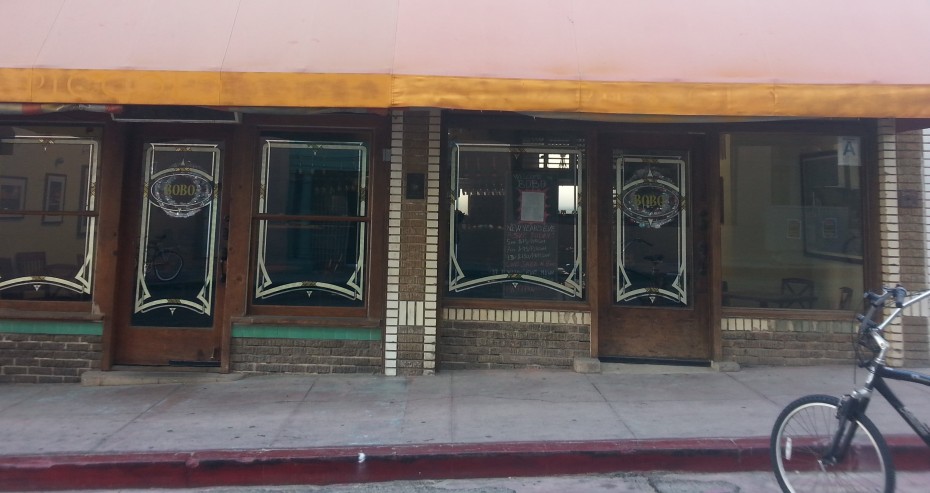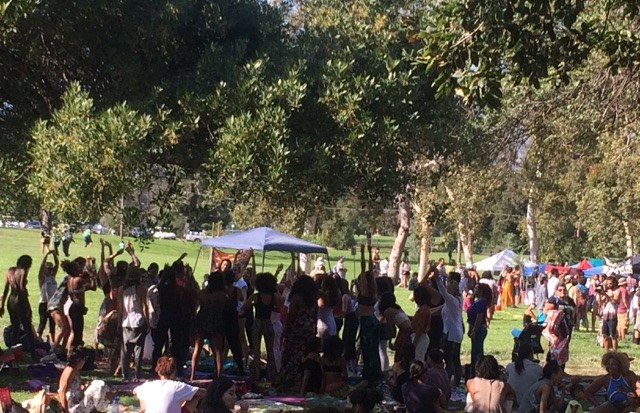
Love-in at Griffith Park, LA August 2017
You can’t turn on the media these days without a commentator remarking on some identity group be it racial, religious, class, gender, or geographic region. It’s called ‘identity’ politics. It’s like the data aggregators on the internet: Anonymous personal characteristics that are used to sell something. One result of identity politics is to diminish the uniqueness of each person and place him into a general group and stereotype a few common qualities to everyone in that basket. In the name of diversity, our common ground is ignored and community dissolved. Perhaps the guy sitting next to you is the ‘other’ as defined by some non-volitional trait. When we put ethnicity and other demographic distinctions over commonality, we splinter into bickering teams.
But fifty years ago the Boomers sought and chose our community—other people who yearned for personal freedom, justice, creative expression, and peace. In the search for community we attended love-ins, established communes, and shared food, weed, and crash pads. This new identity was celebrated in recently deceased Charles Reich’s Greening of America in 1971. Although one of the older generation, he embraced our vision and culture. He quit his tenure-track professorship at an elite university, moved to San Francisco, and changed his sexual orientation.
But these days a sense of place can be hard to find. Where is the San Francisco or Berkeley of today. A place that embodies a zeitgeist and world-view distinctly different. In the wake of globalization, we’ve homogenized so much that one gets a similar culture in almost every big city. When folks ask how long I’ve lived in my city, I usually say, “I’m the local’s local.” And these days it doesn’t feel like community. Rapid densification of the town, the infusion of the tech industry, and a world-wide tourist barrage, it doesn’t look or feel like MY community anymore. It’s a southern California version of modern life with the downtown real estate cabal that makes deals with the politricksters, who pose as progressives, while making secret deals with the real estate developers. Not community, but a marketing plan for maximum profit.
But what is community? Is it our ethnic or racial background? Some claim community in religious orientation or ethnicity or so-called ‘race.’ But those tend toward the tribal (an aggregate of people united by common ancestors, customs, and traditions) orientations that one either is or is not. But community offers something different, a sense of belonging regardless of affiliations or identities. When I worked for the LA school district, headquarters came up the idea forming school communities with the hope of fostering a sense of belonging. All of the elementary (usually 6-9) and the middle schools (2) that fed into the senior high school of that area were declared a community. The plan was to improve articulation of the feeder schools to facilitate the matriculation of students through the ‘community.’

The author, his assistant Mija, & the cameraman JP at Love-in, Griffith Park
Improved communication and articulation between the different levels would reduce the drop-out rate and improve test scores, because the ‘community’ knew and cared about the individual students. As new fads tend to in education, it went away in a few years with no noticeable improvement in communication or test scores. Community can’t be forced.
Back in the Sixties we had community, a sense of belonging to something beyond ourselves. Music, fashion, art, lifestyles, all seemed to emerge organically and spontaneously out of the ethic of freedom, expression, and potential. I felt it in high school when the excitement of the hippie ideas spread through the underground press, specifically the Los Angeles Free Press in my Los Angeles suburb. I jumped in with a lot of other youths. Our way-showers, the Beatles, went to India and pretty soon everyone was wearing beads and Nehru jackets. I scavenged around the garage and found an old Navy uniform of my father’s that kind of looked Nehru. I wanted to signal my belonging to that community and put on the costume. Following the Indian chic vibe, a rock band of local kids had a mega hit record, Incense and Peppermints. Soon after, the Strawberry Alarm Clock played at my high school fully outfitted in kaftans and patchouli incense.
When I wore such hippie regalia, I belonged to something bigger, not defined by my ethnicity or religion or even my neighborhood. MY PEOPLE were those who dressed a certain way, listened to certain music, and wore long hair and beads. I wanted to be with fellow-travelers who thought and expressed as I did. Rarely addressed in the mainstream media, hippie was not just about getting high and listening to music, the prime driver was the urge to be with each other.
The biggest party at the seminal rock festival, the 1967 Palm Springs Pop Festival, was at Taquitz Falls, not the venue (a drive-in movie) where Eric Burden and the Animals played. Music was the honey, but the glue was the community. This sense of the collective got rolling at the Human Be-in in January of 1967 in San Francisco. The main attraction was not Grateful Dead or Jefferson Airplane who played the music, it was the gathering of the hippie tribes in the Bay Area, hosted by the likes of Beatnik poets (Allen Ginsberg) and psychedelic researchers (Timothy Leary), and (in today’s vernacular) other ‘influencers.’ The Diggers Commune hosted with free food and clothes. Community called and thousands answered. The idea caught on in LA with the first love-in that Easter. (see post, There’s Still Love-in the Park, for 50 year reunion in 2017.)
Soon followed-up with the Easter Sunday Love-in, 1967 in LA, a crowd of almost 30,000 congregated in Griffith Park with only a few days’ notice. News reports from that day say that the bands were incidental and no one even bothered to note who played. A couple years later as I grew into my affiliation with the counter culture, I made the long drive to Griffith Park to hang out with my people, my community at the Sunday afternoon Merry-Go-Round love-in. But not only at parks and demonstrations, a sense of togetherness pervaded the culture. Go to a concert and you would expect a joint passed to your buddy would eventually fade away into the crowd. Nobody wanted to be accused of bogarting a joint.
That was the ideal and naturally within that community schisms appeared. Initially put-off by the fun-seeking hippies, political radicals tended to be serious and focused. But by 1968, hippies and radical had merged due to the genius of Jerry Rubin and Abbie Hoffman’s Yippie. They brought together the sense of freedom, creativity, and fun to their anti-war movements protests. By the time I got to Berkeley in 1970, I listened to hippie music at venues like the Fillmore and marched against the Vietnam War in Golden Gate Park. Highlighting the integration of the anti-war movement and the counterculture, I attended a free concert by the Youngbloods at Berkeley’s central park, renamed Provo Park after the radical protest group in Amsterdam. In unison a thousand college students, street people, old lefties, and the police sang ‘Get Together.’ For a moment it felt that way, but the unity was short-lived.
As the war lingered on, impatient political types became more radical and the short-lived community of hippie/ radicals disintegrated. COINTELPRO (the FBI’s campaign against political dissent) infiltrated the Black Panthers and other radical groups. While fed-up with the lack of progress, violent cabals like Weather Underground emerged. At Cal, I had a sociology class instructor, Hal Jacobs, who knew the Weather Underground and to my impressionable ears endorsed them. Not long after the quarter, he disappeared from campus. Soon, the remnants did go underground, while most other radicals found renewed faith in electoral politics and joined the McGovern campaign.
Concurrently, the idyllic sounds of country as first played by the Byrds, then Linda Ronstadt, the Flying Burrito Brothers, and the New Riders of the Purple Sage got the attention of the more laid-back types. The Whole Earth Catalog encouraged a counter-cultural do-it-yourself ‘back to the land’ movement. Armed with a how-to bible and building on age-old American utopian ideas; many of the former peace and love types escaped the cities to live in communal farms.
The symbols of those times; rock music, Indian (east and American) clothes, drugs like cannabis, LSD, and mushrooms—were the forms, not the essence of the Sixties. Bursting out of Fifties conformity, freedom in community called us and inspired us to hope for and seek idealistic lifestyles. Coming together gave us power and the dream that we could build a better world—A world beyond war, consumerism, and prejudice. At the same time, a slogan of the time ‘Do Your Thing’ gave some license to abuse the communal aspect. At the 2017 Griffith Park love-in, I spoke with a woman who went there in the late Sixties. She said the whole scene broke down when the Hell’s Angels discovered the hippies and assaulted the girls and stole stuff.

Poster from LA Free Press announcing the first love-in, 1967
Community inspired the counterculture and naivete doomed it. Out of balance and lacking the wisdom to moderate contradictory values for the good of all, by the mid-Seventies, the counterculture community returned to abstraction, not something you experienced. Disillusioned many communards moved back to the city, while former ‘on-the-lam’ radicals earned graduate degrees and college teaching positions. Looking for fellow-travelers, I moved to a shabby beach side community where outposts of hippie had rooted. We had the Fox Venice, Van Gogh’s Ear, the One Life, and the Small World Books, but no longer coming together as brothers and sisters, we were consumers living our individual lives. And the generation that sung along with the Youngbloods and John Lennon transitioned into the ‘Me Generation.’ And now, sadly the tribal/ identity feuding nation.
C’mon people now
Smile on your brother
Ev’rybody get together
Try to love one another now.
Dino Valenti





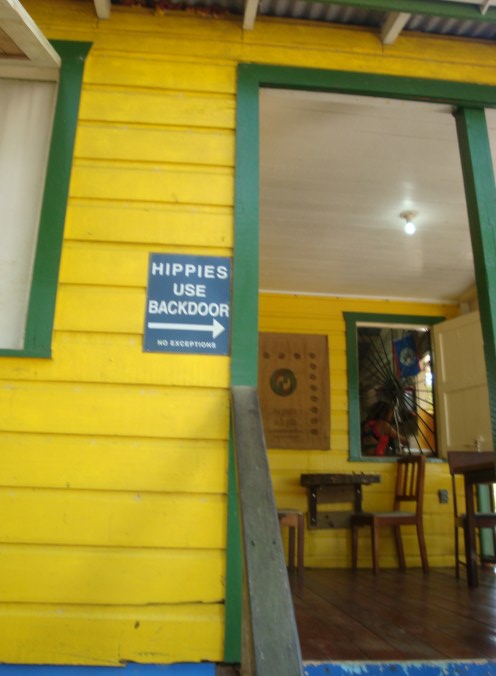
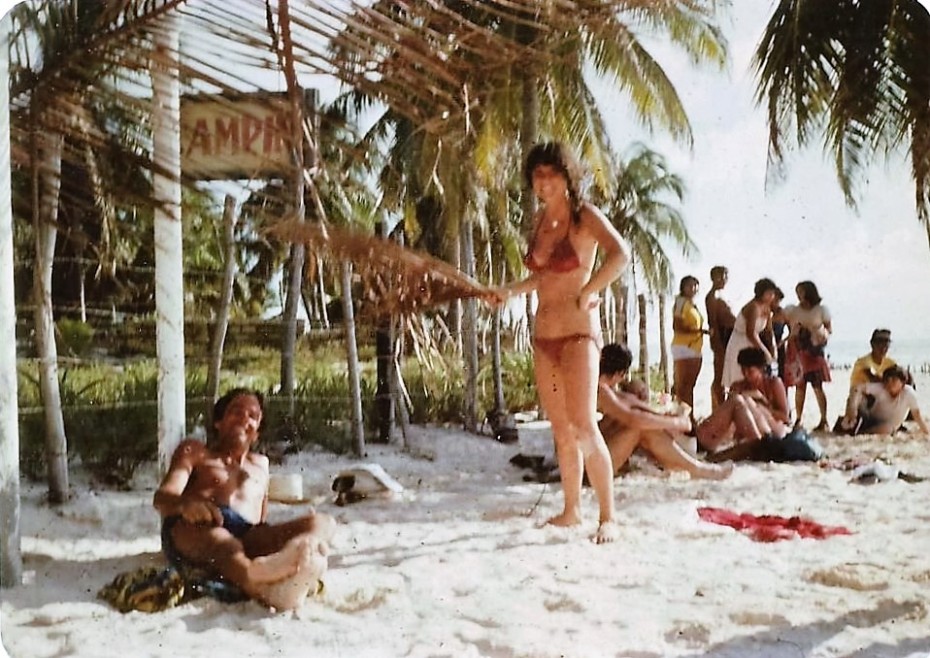
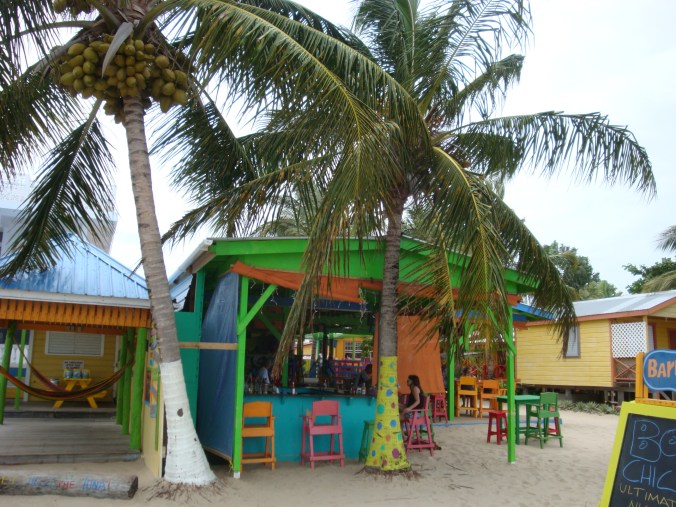














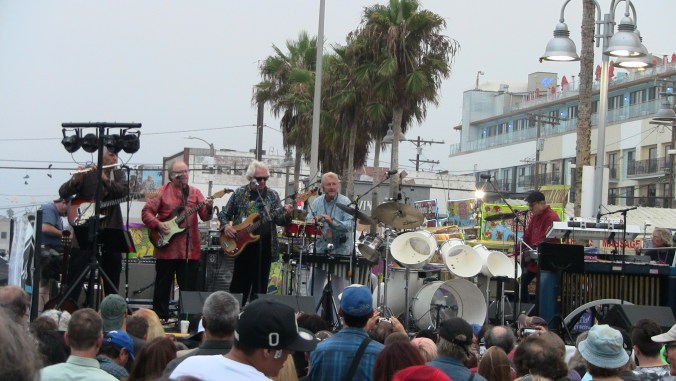






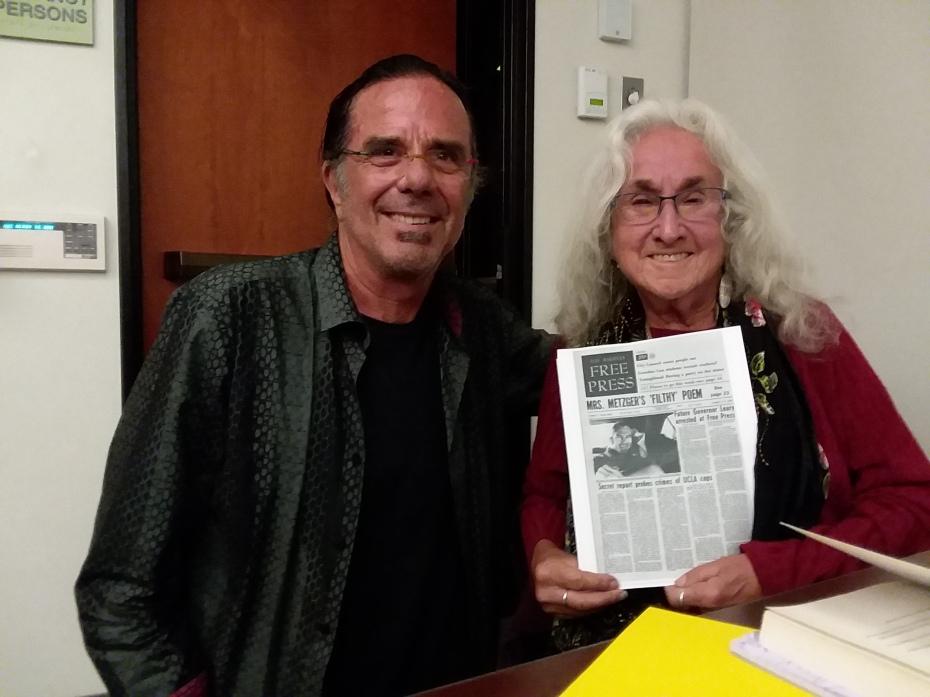 RW and Deena Metzger at her reading at the Topanga Public Library, October 217
RW and Deena Metzger at her reading at the Topanga Public Library, October 217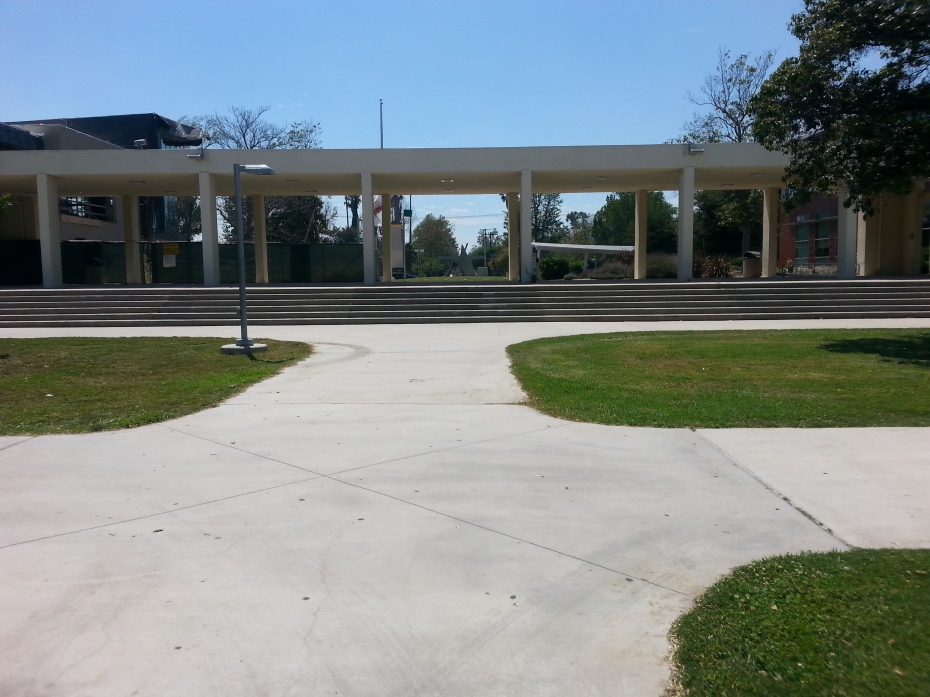 Free Speech Plaza, LA Valley College, 2016
Free Speech Plaza, LA Valley College, 2016



 LA’s original love-in followed the previous year’s police riot on the Sunset Strip. Heads were banged and many youths arrested, while protesting the demolition of a popular teen hang-out (Pandora’s Box). Immortalized in Steven Stills’ For What It’s Worth by Buffalo Springfield, the song announced a new, assertive attitude from teenagers. Rather than turning up the pressure, the police took a different tack at the Easter love-in a year later, very few arrests were made and even the Los Angeles Times gave a neutral, if muted report.
LA’s original love-in followed the previous year’s police riot on the Sunset Strip. Heads were banged and many youths arrested, while protesting the demolition of a popular teen hang-out (Pandora’s Box). Immortalized in Steven Stills’ For What It’s Worth by Buffalo Springfield, the song announced a new, assertive attitude from teenagers. Rather than turning up the pressure, the police took a different tack at the Easter love-in a year later, very few arrests were made and even the Los Angeles Times gave a neutral, if muted report.




